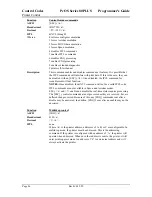
Programmer's Guide
PcOS Series 80PLUS
Control Codes
Printer Status
Rev B 4/13/99
Page 51
Function
Request printer reset
ASCII
[ENQ] <10>
Hexadecimal
05H 0AH
Decimal
<5><10>
Function
Reset printer
Response
ACK <10> (06H 0AH)
The command was accepted.
NAK <10> (15H 0AH)
The command was rejected.
Description
The ENQ <10>, EPOS DLE ENQ n commands, and the INIT pin all
have the same effect and are termed reset commands. To prevent data
loss, the printer will try to complete printing of any buffered data. This
will fail if for any reason operator intervention with the printer is
required. The reset operation is saved until the printer goes idle. In the
case of the slip request command or any command that waits for the
operator, the printer is idle. If the printer is idle and a reset is received
or is pending, the printer will reset and the buffer will be cleared. If an
operator intervention operation is reset by the host, any remaining
buffered data will be cleared.
When the printer receives a reset command, the printer will go off-line
and/or busy until the reset is completed. In serial mode, the printer can
have information in its high-speed buffer that was received after the
reset, but before the reset was processed. If the host application
continues to send information to the printer after a reset command,
some of that information may be processed before the reset is
processed. In parallel mode, the printer will go busy after the reset is
received, but before the next byte is accepted.
The printer will accept an [ENQ]<10> in parallel mode. It will not be
acknowledged however. If both the serial and parallel ports are active,
the serial reset will not be acknowledged either. This is because the
reset operation will remove the parallel response. In IEEE 1284 mode,
the response buffer is cleared by a reset command. This prevents
responses in IEEE 1284 mode as well.
NOTE:
There is a menu selection that will block this command. If
reset inhibit is set in the configuration menu, this command will be
ignored.
















































